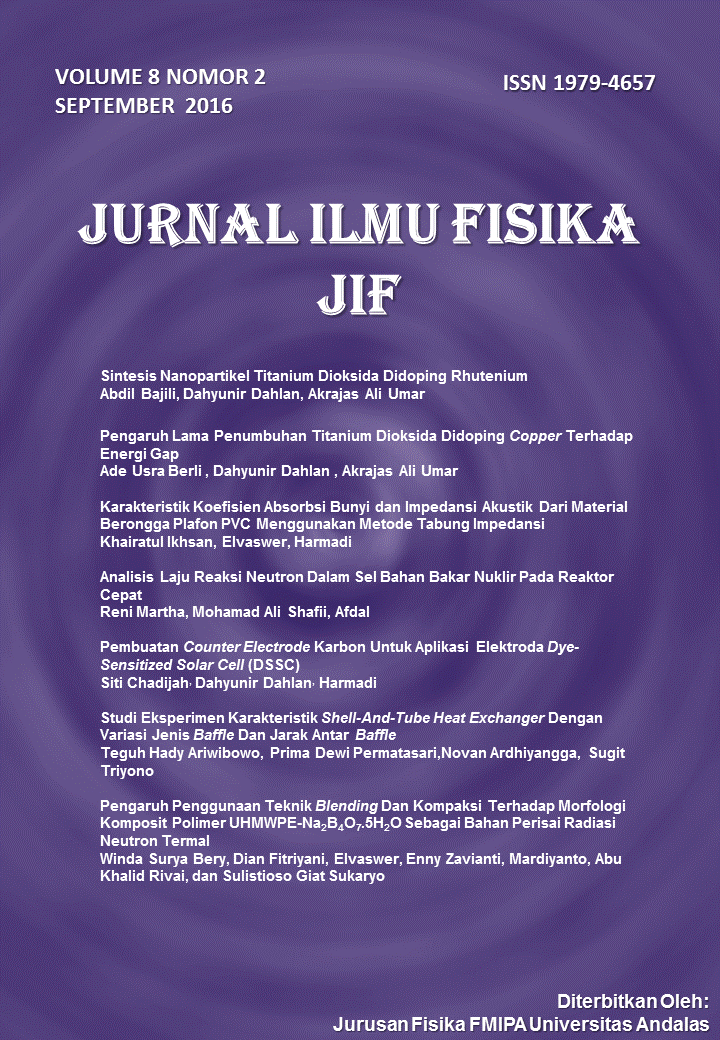Pengaruh Penggunaan Teknik Blending Dan Kompaksi Terhadap Morfologi Komposit Polimer UHMWPE-Na2B4O7.5H2O Sebagai Bahan Perisai Radiasi Neutron Termal
DOI:
https://doi.org/10.25077/jif.8.2.98-103.2016Abstract
Telah dilakukan pembuatan dan karakterisasi komposit polimer UHMWPE dengan filler Na2B4O7.5H2O sebagai bahan perisai radiasi neutron termal. Pembuatan bahan dilakukan dengan menggabungkan UHMWPE dan Na2B4O7.5H2O menggunakan metode blending untuk menghasilkan komposit yang homogen, dan proses kompaksi untuk meminimalkan jarak antar partikel penyusun bahan. Persentase penambahan Na2B4O7.5H2O yang digunakan bervariasi dari 0% hingga 52%. Bahan dasar dan filler di-blending pada suhu 165°C selama 15 menit, selanjutnya dikompaksi dengan pembebanan 10 ton. Hasil analisis EDS menunjukkan persentase massa filler di permukaan bahan meningkat dengan penambahan Na2B4O7.5H2O hingga konsentrasi 40% dan menurun di 52%. Hasil karakterisasi SEM menunjukkan persentase filler optimum pada 40%. Dengan demikian metode blending dan kompaksi sesuai digunakan untuk mencampurkan UHMWPE dan Na2B4O7.5H2O menjadi bahan perisai neutron termal dengan perbandingan komposisi (60:40)%.
Â
Kata kunci :Â Perisai radiasi, neutron termal, UHMWPE, Na2B4O7.5H2O, filler, blending, kompaksi
Â
Downloads
Downloads
How to Cite
Issue
Section
Citation Check
License
Please find the rights and licenses in JIF (Jurnal Ilmu Fisika).
1. License
The non-commercial use of the article will be governed by the Creative Commons Attribution license as currently displayed on Creative Commons Attribution-NonCommercial 4.0 International License.
2. Author's Warranties
The author warrants that the article is original, written by stated author(s), has not been published before, contains no unlawful statements, does not infringe the rights of others, is subject to copyright that is vested exclusively in the author and free of any third party rights, and that any necessary written permissions to quote from other sources have been obtained by the author(s).
3. User Rights
JIF's spirit is to disseminate articles published are as free as possible. Under the Creative Commons license, JIF permits users to copy, distribute, display, and perform the work for non-commercial purposes only. Users will also need to attribute authors and JIF on distributing works in the journal.
4. Rights of Authors
Authors retain the following rights:
- Copyright, and other proprietary rights relating to the article, such as patent rights,
- The right to use the substance of the article in future own works, including lectures and books,
- The right to reproduce the article for own purposes, provided the copies are not offered for sale,
- The right to self-archive the article.
5. Co-Authorship
If the article was jointly prepared by other authors, the signatory of this form warrants that he/she has been authorized by all co-authors to sign this agreement on their behalf, and agrees to inform his/her co-authors of the terms of this agreement.
6. Termination
This agreement can be terminated by the author or JIF upon two months's notice where the other party has materially breached this agreement and failed to remedy such breach within a month of being given the terminating party's notice requesting such breach to be remedied. No breach or violation of this agreement will cause this agreement or any license granted in it to terminate automatically or affect the definition of JIF.
7. Royalties
This agreement entitles the author to no royalties or other fees. To such extent as legally permissible, the author waives his or her right to collect royalties relative to the article in respect of any use of the article by JIF or its sublicensee.
8. Miscellaneous
JIF will publish the article (or have it published) in the journal if the article's editorial process is successfully completed and JIF or its sublicensee has become obligated to have the article published. JIF may conform the article to a style of punctuation, spelling, capitalization, referencing and usage that it deems appropriate. The author acknowledges that the article may be published so that it will be publicly accessible and such access will be free of charge for the readers.



